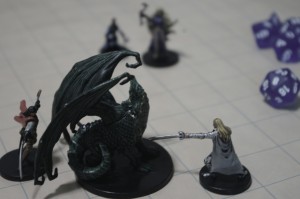I’m a postdoctoral at a university. My job is doing research, but this semester I’m also teaching a class. It’s the first one I’ve had the opportunity to design from scratch. In preparation, I took a workshop in course design from the University of Calgary’s Teaching and Learning Centre. The three-day seminar featured a lot of great advice about getting from idea to complete syllabus, but one comment the facilitator made really stood out. He said that the current consensus in teaching and learning is that our job is designing environments.
When I first stepped into the classroom a few years ago, I thought of myself as a kind of editor. The bulk of my job was the selection of what my students would read and discuss, and my lectures basically served as introductory essays to frame their reading. But this idea of designing environments for learning resonated because of the experience I’ve since had as a Dungeon Master (DM).
For those of you who have never played (!?), tabletop fantasy role-playing games (RPGs) like Dungeons & Dragons (D&D), involve a group of players in an interactive story. Most of the players control a single character, who has motivations and goals, a personality, and a quantifiable set of attributes and skills. But one player, the DM, doesn’t control a character; he or she controls the whole world. The DM creates the story and is responsible for everything that happens—though most RPGs also involve a certain amount of random chance to keep things interesting.
A teacher is the DM of the classroom, and I think I’ll be a better teacher if I keep in mind some things that I’ve learned from playing D&D with my friends.
Encounter, Adventure, Campaign
Most role-playing games are persistent. From week to week, you control the same players and the story continues building up based on what happened before. Like serial entertainment, then, it works best when it’s layered and incorporates multiple tempos: A storyline, B storyline, season-long C storyline.
The basic building block of a D&D game is the “encounter.” Usually, these are combat encounters, where you run into some monsters and have to defeat them. More generically, you might say that an encounter involves an obstacle that has to be overcome somehow to proceed. A group of encounters oriented towards a single goal or objective is an adventure (which may involve one or more side quests along the way). The frame in which all this takes place, as defined by some combination of the same players, characters, and setting is a campaign.
A fun, satisfying campaign will have certain developing themes between adventures. Individual encounters will not only provide an interesting challenge in themselves but also propel a longer plot forward. Similarly, if we think about a student’s whole university experience as their learning campaign, then a course or series of courses is like an adventure, which has specific, distinct outcomes. Each reading, lecture and discussion is in the deepest sense an encounter, and each of these encounters should propel us towards our goals and objectives.
Multiple Hooks for Different Learners
I’m not really a big fan of the “learning styles” meme, insofar as that’s interpreted as some kind of biologically essentialist feature of learners’ brains. But I do believe that people come to the table with different interests and motivations, and that has consequences for how they experience your class.
In D&D’s manuals for Dungeon Masters, there’s a relatively elaborate typology of “kinds” of gamers: that is, players who are interested in different aspects of the game and, thus, judge how much fun they’re having in different terms. The Dungeon Master’s Guide provides advice on how to interest and involve each of these player types, as well as what kinds of difficulties you might expect from them.
As a teacher, just like a DM, I want to provide different hooks into the subject for different learners. That means trying to get a sense early on of what people are looking for in the class. Students don’t get to define the course’s objectives or its place in the curriculum, but you can work with them to find connections to their own goals and interests.
Challenge
One of the most important things the DM has to do is design all those encounters. That not only means figuring out what happens, where, and why, but working out all the details: What monsters will the players face, and what tactics will they, the monsters, use? Are there traps or other hazards that will present additional challenges?
The trick here is hitting a sweet spot in difficulty. If the players are relatively powerful, they can plow through those monsters without their characters facing any real danger. But where’s the fun in that? Conversely, an encounter where the odds are stacked heavily against the players or, worse, there is no way for them to win quickly becomes tedious and frustrating.
A recent article in University Affairs addressed failure as a pedagogical strategy, and I think that’s really relevant to finding this sweet spot I’m talking about. The idea is that letting students grapple collaboratively with something a little above their level will lead them to develop problem-solving skills in a way that asking them to do something they already know how won’t. I don’t know that the language of failure is particularly helpful, but I do think this kind of problem-oriented pedagogy (which I’ve experienced most directly teaching in research methods labs) is a good bet for finding that sweet spot I was talking about.


